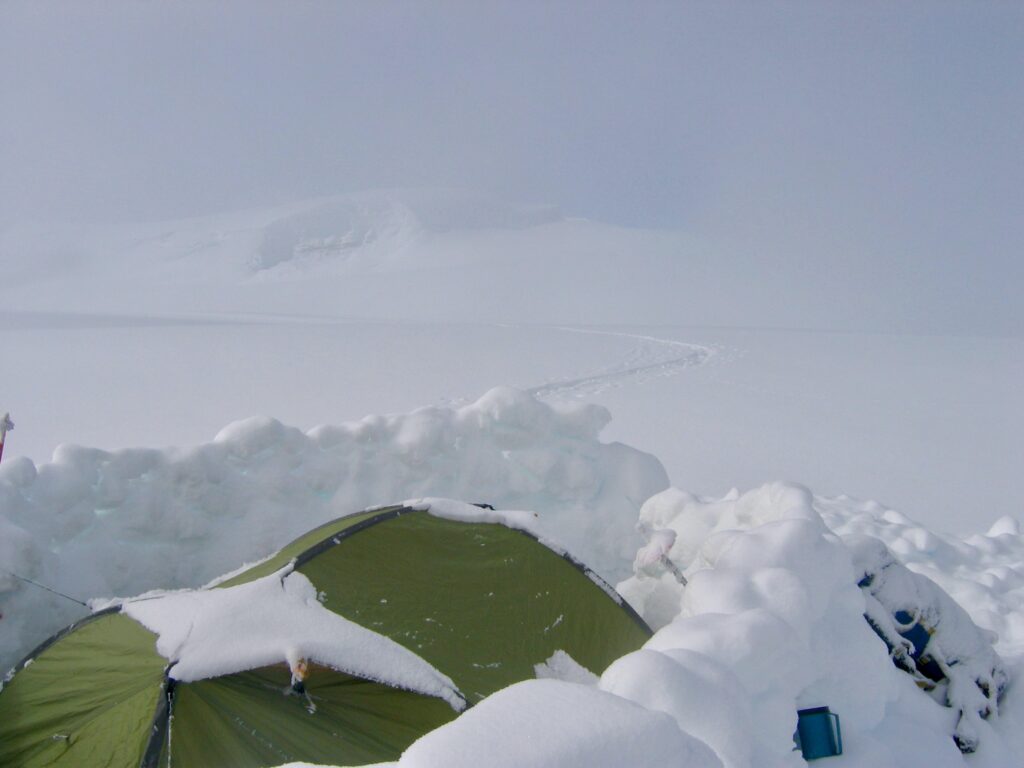“Is there anybody there?” said the Traveller,
Knocking on the moonlit door;
And his horse in the silence champed the grasses—”

“It’s ‘chomped’, Dad! Not champed . . . ”
“No it isn’t, it’s ‘champed’. Do you think I don’t know the poem?” I took out the Photostat copy, and shining my headlamp on the paper I showed Liam. “There! See! ‘Champed’.”
“’And his horse in the silence CHAMPED,’ ” Liam sniffed, in his view the poet was a chump for not using ‘chomped’, “’the grasses
Of the forest’s ferny floor:
And a bird flew up out of the turret,
Above the Traveller’s head:
And he smote upon the door again a second time;
“Is there anybody there?” he said.
But no one descended to the Traveller;
No head from the leaf-fringed sill
Leaned over and looked into his grey eyes,
Where he stood perplexed and still.
But only a host of phantom listeners
That dwelt in the lone house then
Stood listening in the quiet of the moonlight
To that voice from the world of men:
“Stood . . . stood . . .’ um . . . What’s next?” Both of us were stumped.
“It’s ‘Stood listening in an air stirred and shaken’ . . . ”
“I don’t think so . . . ‘Stood . . .stood—THRONGING!”
“That’s it—‘Stood thronging the faint moonbeams on the dark stair’
—Then what?”

Neither of us could remember the next line. But we had done all right, learning half the poem by heart as we sat around the fire.
I first heard Walter de la Mare’s poem, The Listeners, when I was Liam’s age. We learned it by heart at school. The poem had always been a favourite for it conjured up wild visions: a haunted house in a scary forest, ghosts, rattling doors and window panes, moonlight—deathly silence. The poem made the night darker. We shivered and drew closer to the fire and watched sparks shoot up like burning filaments. The moon was full that night and it hung above the mountain opposite casting long ominous shadows through the trees, all ghostly and silent under the deep snow. A more different place than the “forest’s ferny floor” could hardly be imagined.
But like the poem, we had the quiet.

Thomas Babington Macaulay, Victorian essayist and historian, was a fervent advocate of the accomplishments of his own century, relishing the spectacle of England’s industrialization as wholly delightful. One of Lord Macaulay’s contemporaries was philosopher and social scientist Herbert Spencer, who, observing the industrial development of England, went into unbounded raptures on the advantages of the new system, stating that the “advancement” of mankind towards a state of “perfection” was a “certainty.”
Had he but known.
We live in the world of dotcom make-believe, where virtual reality has become the real thing by default. The magic has gone, the imagining has gone, the poetry gone, all swept away by the transparency of what you see is all there is. When you can see it, even if counterfeit, there is no imagination.

When Henry Ford introduced the assembly line in his factory, and other industrialists quickly followed, it could be said that this was the beginning and the end of imagination all at the same time. Great imagination for those who came up with the invention, but for the assembly line worker it was a shattering blow, turning a thinking person into a robot, more or less. Is it any different today, with technology turning us into little more than spectators of some garish reality show?

But our souls ache in this addictive technology, the modern-day equivalent to those dark Satanic mills, for things not seen, for beautiful and elevated thoughts, imaginings to stir the emotions. C.S. Lewis said “I never mistook imagination for reality.” But we’ve mistaken the reality of the screen for imagination. It’s easy to do when it’s constantly in your face.
The screen is two-dimensional: what you see is what you see. But there is no boundary in the imagination, it is not confined by dimensions any more than a vast prairie sky. It’s not the candy-coated world of the computer screen, the fluff of eye candy and ear candy that satisfies the soul, it’s imagination. Today, if there is a measure of imaging, it is mostly fancy, the lighter and more decorative faculty that flits about just beneath the surface, a superficial delighting and entertaining; it’s the tinsel on the Christmas tree. Whereas imagination transforms and exalts, moves and thrills, it transcends the work of fancy—it’s the tree itself. Imagination is not only poetic or literary, but scientific, philosophical, and practical, the seat of deep thinking.

Imagination is the mind’s eye of the soul.
The development of the Romantic poets, such as Wordsworth, Coleridge, Lord Byron, Percy Bysshe Shelley and John Keats paralleled the Industrial Revolution, these so-called poets of nature taking one back to oneself, from a world too noisy even to think. Later, many of the Victorian poets, such as Matthew Arnold, Edward Fitzgerald, Dante and Christina Rossetti, William Morris and to some extent Alfred, Lord Tennyson, wrote to soothe souls from the pounding steam power that tyrannized almost ever facet of society. It offered escape from a world fast-surrendering to scientific determinism, a luxurious sensual warmth to counter the despair so many saw in the heartless doctrine of the survival of the fittest (a concept propounded, incidentally, by Spencer several years before Charles Darwin set forth his theory of evolution).

Today, not only is our world too noisy, it’s too busy, and if those living through the upheavals of the Industrial Revolution and it’s immediate aftermath needed poetry, or what was represented by poetry, then in this second wave of the industrial revolution surely we must need it too?
By a strange paradox our world, at times, is too silent, particularly within the office. These places, rather than humming with the rhythm that something important is being accomplished, now have an uneasy type of silence. The only noise the tapping of keyboards like the sound of mice running over empty cardboard boxes. Not so much a silence perhaps, more a vacuum of nothing at all. Everyone in their cubicle, in their own piece of space, days spent clamped under a grid of technology, typing commands to China—which, for all its connection with the office worker, might just as well be Pluto. It’s not a silence that heals the soul, it’s an uncomfortable silence that disturbs the soul, that makes you wonder what the hell is really going on. It’s the silence of the mesmerizing cursor, blinding the mind, killing the soul.

Poetry is music, language, art, all of these things; it is the closest form to a painting. It’s beauty of thought that feeds the imagination and emotions (soul food, if you like). It’s not reading words so much, rather it’s seeing the power of the thoughts they convey, hearing the music in your soul.

Soldiers in the trenches of World Ward I, in the desert campaigns of World War II, wrote poetry, a need for elevated thought amid the carnage, an escape from the brutal reality. I imagine that in Ukraine some of those soldiers in the trenches are writing poetry. That’s what poetry is, the expression or embodiment of beautiful or elevated thought, a soothing of our souls, adorning the imagination in an ugly world.
You can’t read poetry as you would a newspaper or magazine, skipping a word here and a line there, skimming the surface before moving to the next stint. To hear the rhythm of life you must listen, to really listen takes time—it’s imagining I’m talking about: to see the stars in the stream. And when you do see, not from the limited dimensions of the computer screen, but in your mind’s eye, well, it makes you shiver right down to your shoes. I’m glad I grew up with poetry: it courses my veins, feeding my soul, it’s saved me from resorting to cheap knockoffs like chicken soup. And now I had the chance of introducing it to Liam—even at 20 below.

It had been a good day in the mountains, we had learned half our poem and for the first time ever we had cooked meat over the fire for supper. We sat talking as the fire burned to glowing cinders. Tomorrow or the next day we would learn the other half of The Listeners.
(To be continued.)
David Harrap // info@thejasperlocal.com
Jasper’s David Harrap is the author of The Littlest Hiker In The Canadian Rockies. Get it at the Jasper Yellowhead Museum and Archives.



